on Jeep Concepts, a Lambo NFT, Porsche & E-fuels, Honda's $40-billion EV Plan
Nowadays few OEMs show concept vehicles. Jeep doesn’t merely show them, it takes them to Moab. NFTs are becoming something of a craze. One lucky Lamborghini buyer will get one. (Huh?) Porsche is going electric—but not giving up on its boxsters. A Mazda CX-30 review, and even more. (This is a shorter week for many people. Read fast.)
Jeep Concepts for Moab & The Importance of Enthusiasm
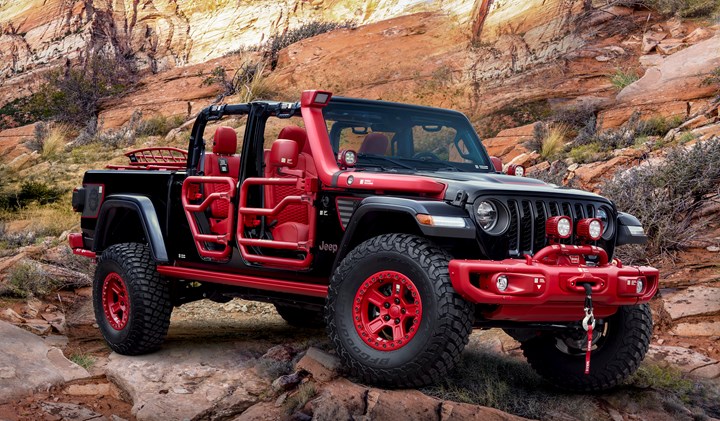
Jeep D-Coder Concept: Red means you can buy those elements to mod your Gladiator. (Image: Jeep)
“They called themselves the ‘Lunatic Fringe.’ They built the first vehicle with their own money.”
In a more officious setting, that outfit would be described as being a “skunkworks” or “loosely organized development team.”*
But Mark Allen, head of Jeep Exterior Design, is talking about the group of engineers that, 20 years ago, put together the first Rubicon for making a run at Moab as part of the annual—now 56 years running—Easter Jeep Safari.
Seems like this Lunatic Fringe was well aware of what the Jeep Faithful were—and are—all about.
The Rubicon package now accounts for about 30% of all Jeep Wrangler sales, according to Allen.
Tribute
For this year’s event they made a tribute vehicle, the Jeep Rubicon 20th Anniversary Concept. It is one of 10 concepts created by Jeep and Jeep Performance Parts (JPP).
Although the original Rubicon Concept was based on a model year 2003 two-door Wrangler, for the 20th anniversary they opted for a four-door: a modified Wrangler Rubicon 392 they tricked out with a special performance hood, custom-built half doors, a JPP 2-inch lift kit, 37-inch tires, a Warn winch, steel belly pan, and more.
Looking back further in Jeep history, the team developed the Jeep ’41 Concept, a nod to the Willys MB of 1941. Yes, it has an exterior paint color that would not have been out of place in ’41, olive D.R.A.B., a matte green finish. The black steel bumpers would also check the box.
But under the hood, it would be science fiction for those Jeep drivers of 80 years ago: the Wrangler 4xe hybrid system.
Two More
There are two interesting Jeep Gladiator-based concepts.
One is the Jeep Bob.
No, it isn’t named after someone named Bob. (Given the approach of the folks in the Jeep design studio it wouldn’t be unthinkable that they would name it after, say, a hometown guy like Bob Seger (although his music was used for those Chevy truck ads. . .).)
Rather, they took a foot off the length of the box of the Gladiator: It has been “bobbed.”
Realize that all of the concepts go out to the nine-day event with exposure to the Jeep-faithful, people who use their vehicles as platforms upon which to construct their dream machines.
So, to facilitate that building. . .
The Jeep D-Coder Concept by JP, based on a Gladiator, is painted Gloss Black. . .except for more than 35 components painted Maraschino Red and have QR codes affixed. These are JPP and Mopar accessories.
So, in effect, the vehicle is like a catalog—scan the QR code and get to the Mopar eStore site—that can crawl rocks with the best of them.
*Want to know why companies really need to have people enthusiastic about what they are working on? Consider this: in Q1 2022 the total sales of FCA US: 405,221 vehicles. That includes Ram, Chrysler, Dodge, Fiat, Alfa Romeo, and Jeep. Jeep’s Q1 sales: 193,281 vehicles, or about 48% of all sales for the company. Get raving workers; get amazing results.
///
Buy an NFT, Get a Lambo
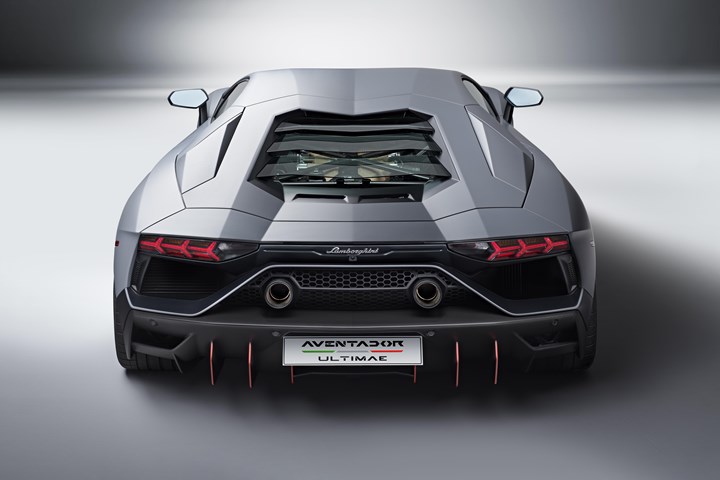
So long, Aventador. (Image: Lamborghini)
Production of the Lamborghini Aventador has come to its end. The LP 780-4 Ultimae will be the last with the naturally aspirated 769-hp V12 that powers the car from 0 to 62 mph in 2.8 seconds.
Lambo is going electrified, which means the vehicles going forward will be hybrids or full EVs.
On April 19 the last Lamborghini Aventador LP 780-4 Ultimae Coupé will be auctioned by RM Sotheby’s.
While that might seem rather straightforward—after all, cars are auctioned all the time, even vehicles more exotic than this—there is a twist.
Artists & a Token
The interior of this vehicle has been worked on visual artist Krista Kim and audio artist Steve Aoki (guidance was provided by Ad Personam, Lambo’s in-house vehicle specialization organization).
And those two artists, working with “global brand storytelling agency” INVNT GROUP, have created a non-fungible token (NFT) that is part of the auction.
This is a singular NFT. One of one.
Why? you might wonder.
“Lamborghini and the NFT community fit together very well, as we share many values. We are both young-spirited innovators, looking out for unexpected projects and technological solutions.”--Stephan Winkelmann, Chairman, and CEO of Automobili Lamborghini.
Comparatively speaking, Lamborghini really is a young(sih) brand, having been established in 1963. NFTs first emerged in 2015.
Other things, too
The person whose bid is accepted will get the sorts of things that are probably best associated with people buying “VIP passes” for music concerts, like special swag and the ability to go backstage and possibly glimpse a performer.
In this case, the buyer gets, among other things, “exclusive virtual previews of future limited edition Lamborghini models, a private tour of the Museo Lamborghini, and a virtual ‘Meet & Greet’ with Steve Aoki and Krista Kim.” Those virtual meetings are 15-minutes long, each.
The buyer will “own the digital replica (GLB file) of the Lamborghini Aventador LP 780-4 Ultimae Coupé - the first Lamborghini car for the metaverse.”
But here’s the thing that is rather breathtaking in the RM Sotheby’s explanation of the auction:
“If the NFT is sold for over €5,000,000, Lamborghini will hold a delivery celebration / dedicated event for the buyer.”
Note: not if the car is sold for over €5,000,000, but the NFT.
Apparently, the physical object is just a bonus.
///
Porsche, E-fuel and Environmental Issues

E-fuels plant in becoming. To address European environmental regs, there would be a whole lot more of these plants required. (Image: Porsche)
Oliver Blume, chairman of the Executive Board of Porsche AG, said last month at the company’s annual meeting, "In 2025, half of all new Porsche sales are expected to come from the sale of electric vehicles—i.e., all-electric or plug-in hybrid. In 2030, the share of all new vehicles with an all-electric drive should be more than 80%."
In 2021 Porsche sold 301,915 vehicles globally. An 11% increase compared with 2020.
Let’s say that between now and 2025 there is an annual 10% increase in Porsche sales.
That gets to 442,033 vehicles.
So by 2025 there would conceivably be some 221,000 vehicles with internal combustion engines (actually more because plug-in hybrids have ICEs, too).
If things go swimmingly well for Porsche and the company’s sales increase an additional 10% each year until 2030, there would be total sales of approximately 712,000 vehicles.
Eighty percent of that is 569,600 EVs. A solid number.
But that leaves 142,400 with combustion engines.
A Fuel Source
Porsche has invested $75-million in HIF Global, a company developing e-fuel production facilities.
Presently HIF is constructing an e-fuel pilot plant in Punta Arenas, Chile. Porsche, Siemens Energy and ExxonMobil are participants in the project.
“E-fuels make an important contribution to climate protection and complement our electromobility in a meaningful way. By investing in industrial e-fuel production, Porsche is further expanding its commitment to sustainable mobility. In total, our investment in the development and provision of this innovative technology amounts to more than $100 million.”-- Barbara Frenkel, Member of the Executive Board for Procurement at Porsche AG.
E-fuels are made with a process wherein electricity—ideally produced via a renewable source—is used to create hydrogen that is combined with CO2—ideally captured from the air.
The result is a liquid fuel that can be used in internal combustion engines.
The proponents of e-fuels say e-fuels are carbon-neutral because there is no additional CO2 produced during combustion.
This is probably a key reason why Porsche is investing in the development of e-fuel capacity: It will help with the combustion engines it will still produce in 2030.
Potential Other Shoe Dropping
Transport & Environment, a European NGO, commissioned a study last year on e-fuels.
The title of the report released in December provides a sense of the conclusion:
Magic green fuels: Why synthetic fuels in cars will not solve Europe’s pollution problems
CO2 is one thing.
But there are others.
T&E:
- “No difference in NOx emissions were observed for any of the e-fuels tested either on the lab or on road tests compared to today’s petrol fuel. This means that e-fuels emit the same amount of NOx pollution as fossil fuels today, so the use of e-petrol in cars will have little impact on NOx emissions which are at the heart of toxic NO2 pollution across Europe’s cities.”
- “Toxic carbon monoxide emissions were much higher with the e-petrol blends tested. Emissions were up to almost 3 times higher on the lab WLTC test and 1.2-1.5 times higher on the RDE test compared to fossil fuel. The largest increase in emissions occurred when the engine was first switched on, which happens often in towns and cities.”
That notwithstanding (not like that isn’t a matter of concern), there’s this:
“T&E estimates that the newly proposed 2030 car CO2 target of -55% would require an additional 3.7million BEVs on the road compared to current policies. If these BEVs were replaced with fossil cars running on e-fuels, 23 billion litres of e-fuel would be needed in 2030 alone. That is equivalent to 189 e-fuel plants with 240 million litre capacity each.”
Which is to say that there would need to be a whole lot more investment in e-fuel plants to get there.
///
2022 Mazda CX-30 AWD Premium Plus

The Mazda CX-30 compact crossover really is a class-above. (Image: Mazda)
The model here has:
- A 2.5-liter, 250-hp turbocharged engine mated to a six-speed automatic (with the now seemingly obligatory steering wheel-mounted paddles for sport shifting). Should the price of premium fuel make you uneasy, know that it provides 227 hp on regular. The price of pep—because when you get on the throttle the CX-30 is nothing if not peppy—is that the EPA-estimated numbers are 22 mpg city, 30 highway, 25 combined, so the numbers are reasonable, not wonderful (though know that in the 186-hp non-turbo version the combined miles per gallon figure is only one mpg better than the turbocharged engine).
- All-wheel drive. Or in Mazda-speak, the “i-Active AWD system,” which includes “Off-road Traction Assist,” and lest you get carried away by the potential for this small SUV, know that the Mazda consumer site describes this feature: “Off-road Traction Assist helps free tires that are stuck when vehicle tires become embedded in mud, sand or deep snow.” You don’t want to go looking for a reason to use it.
- The “Premium Plus” package, which means front and rear parking sensors, traffic jam assist, auto-dimming driver-side mirror, Homelink, 360-degree view monitor, smart brake support-ear, rear cross-traffic braking.
- Leather seats. Heated front seats and steering wheel. A sliding glass moon roof. Rain-sensing windshield wipers. Bose audio. A 8.8-inch color display in the IP. And much more.
The model here has:
- A sticker that, including a $1,225 delivery, processing and handling fee, reads “$35,750.”
According to Kelley Blue Book, in March 2022 the average transaction price for a Compact SUV/Crossover was $33,690.
Or about two grand less than the sticker on this CX-30.
However, KBB also calculated that the average transaction price for a Luxury Compact SUV/Crossover was $53,361.
Class above
While not suggesting that Mazda is a luxury brand, I would go so far as to suggest that in terms of exterior styling, interior amenities and overall execution, the CX-30—with the AWD, turbo and Premium Plus package—is certainly in a class above what one might think of as a “mass market” vehicle in this category.
If you spend some time looking at the various aspects of the vehicle, you’ll quickly conclude that there was a considerable amount of attention being paid to the elements that go into making it a unified whole, and it is attention on getting things done right rather than attention that seems to have as its focus cost reductions that would benefit the manufacturer, not the consumer.
An increasing number of OEMs seem to be paying less attention to their customers and more to their stock prices, and things like well-formed sheet metal and details on the interior go by the wayside.
Plainly said: I am an unabashed fan of Mazda styling, and while there are those for whom Mazda is the brand that has long had exemplary ride and handling (think: Miata), the execution of the sheet metal and the materials on the interior are something that does it for me.
I always wonder how they (a) get away with such expressive styling and (b) are able to do such good interior execution, given that Mazda is a comparatively small brand with low(ish) volumes and so don’t have the scale economies of bigger OEMs.
And then I wonder how come the bigger OEMs don’t manage to do as good a job as Mazda.
///
Transaction Prices Decline in March—0.3%
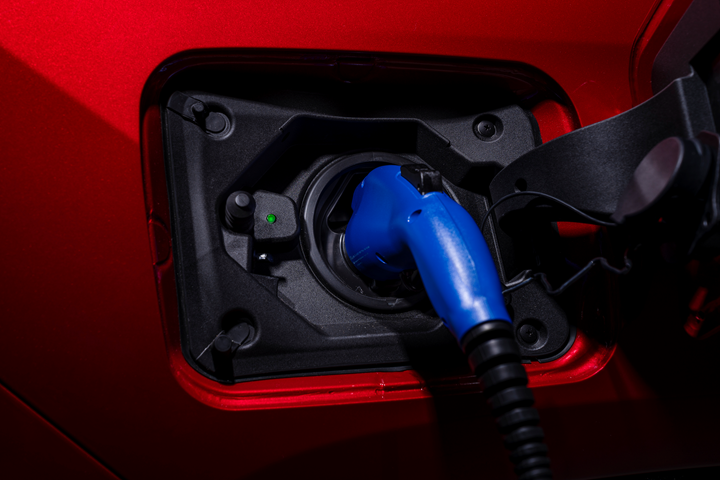
Toyota sold 1,585 RAV4 Primes—the plug-in hybrid—and 15,771 RAV4 Hybrids in March. (Image: Toyota)
Speaking of Kelley Blue Book stats. . .
The good news is that for three months running, the average transaction prices (ATPs) for new vehicles in the U.S. have decreased. . .so that the number for March is $45,927.
In December 2021, according to Kelley Blue Book, the ATP was at a record level: $47,077.
However, the March 2022 ATP is 12.9% higher than the March 2021 number.
What’s more (and it is more), consumers have paid above the sticker for the past 10 months. In March it was 9% over invoice. (Wonder if dealers are taking Sharpies to the Monroneys.)
The not-so-good news:
"With a myriad of supply chain issues disrupting global vehicle production, we expect inventory to remain tight through the rest of the year and prices to remain high"--Michelle Krebs, executive analyst for Cox Automotive.
What do people want?
Hybrids.
Based on the ATP percent change from March 2021 to March 2022, the “Hybrid/Alternative Energy Car” category is up 26.9%.
Second-biggest increase over that period? “High-end Luxury Car,” at 20.5%.
Although the ATP in March for hybrids is below the overall average at $38,545, prices for those vehicles are up 8.6% over what they were in February.
Who’s happy?
Toyota.
In March it sold 17,356 RAV4 hybrids.
To put that into perspective, in March Ford delivered 15,136 Escapes—of all powertrain types. Including the Escape Hybrid.
///
Rena Max: Delivering in Style
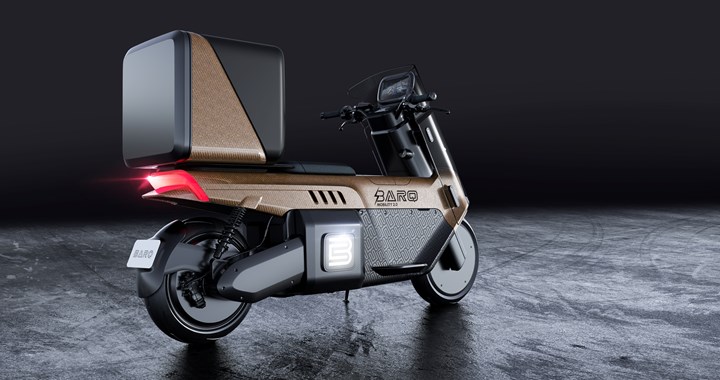
“Rena Max has a sense of style that is sometimes forgotten with future mobility solutions.”—Ian Callum (Image: Barq)
Ian Callum, CBE, has designed some of the most magnificent motor cars—such as the Aston Martin Vanquish and the Jaguar F-Type—so it comes as no surprise that Callum, who established the self-referential design firm CALLUM in 2019, after his retirement from Jaguar, where he headed design, has developed. . .a last-mile delivery scooter for Barq, a company based in Abu Dhabi.
The electric scooter, the Rena Max, was designed for use in the Middle East and North African (MENA) markets.
So the handlebar grips are a light blue polyurethane and the vinyl blue seat has a diamante texture both to address the heat in the area.
The body panels are UV-resistant.
It delivers
Because this is a delivery vehicle, there are three storage compartments (79-liter box in the back, insulated with a food-safe liner; a nine-liter cool box; and a five-liter unit in the front).
“Riders said it was important to carry enough fluids to stay hydrated for their whole round. So, we created a personal stowage area for their drinks bottle and belongings with further capacity to carry a pair of two-liter bottles or large fast-food cups upright,” says Aleck Jones, CALLUM creative lead.
The Rena Max uses 5.6-kWh swappable lithium-ion batteries. There is a 9-kW motor. The top speed is 97 kph. The range is said to be up to 150 km per charge.
Although it was specifically developed for the MENA markets, with initial applications occurring in the UAE, Saudi Arabia and Egypt, according to a CALLUM spokesperson, “There is no reason it could not perform elsewhere.”
The average high in Abu Dhabi in July is 107°, so if the Rena Max can make it there. . . .
///
Honda’s Electric Efforts
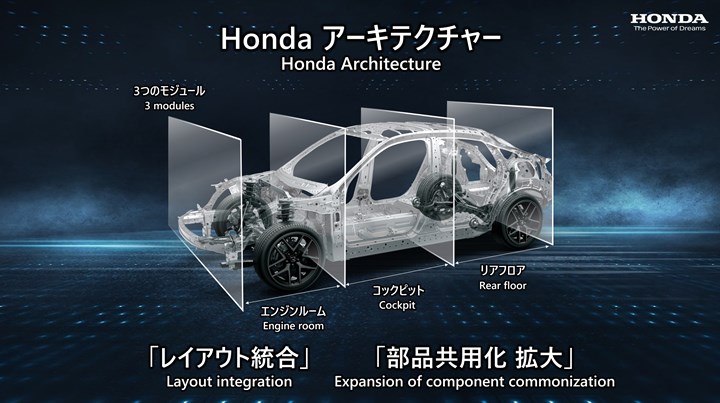
Honda’s approach to EV architecture. Note the word “commonization.” It is key to achieving scale, which is key to reducing costs. (Image: Honda)
There is an old joke that Honda is an engine company that happens to produce cars.
Seems that that is now being embraced by the company because in a briefing conducted on April 12 by Toshihiro Mibe, director, president and representative executive officer about Honda’s plans for electrifying its portfolio—including investing some $40-billion over the next 10 years and launching 30 EV models globally by 2030 (with an annual production volume of >2-million units)—it was noted that Honda is “the world’s largest power unit manufacturer.”
Those power units take the form of some 30 million “mobility products including motorcycles, automobiles, power products, outboard motors and aircraft.”
A Re-org
As part of its new strategy, Honda is reorganizing from product groups—motorcycle, automobile, and power products—to an umbrella organization called “Business Development Operations” that will encompass technologies including electrified products and services, battery, energy, software/connected services, and others.
The notion is that this will allow “cross-domain” synergy among products.
As in: if battery-swapping tech is developed for scooter applications, that know-how will then be more readily accessed for automotive development.
Cost-down
One of the things that tends to be overlooked in OEM announcements about spending for “THE FUTURE!” is that efforts must be made to reduce costs elsewhere.
Notably, Honda pointed out that it has reduced the trim/option variations across its global production output by half compared to the available number in 2018 and that it is working to get to one-third by 2025.
In addition, it is working to reduce its global automotive production costs 10% compared with 2018.
Every little bit matters. $40-billion is a lot of money.
###
RELATED CONTENT
-
GM Is Down with Diesels
General Motors is one company that is clearly embracing the diesel engine.
-
On Electric Pickups, Flying Taxis, and Auto Industry Transformation
Ford goes for vertical integration, DENSO and Honeywell take to the skies, how suppliers feel about their customers, how vehicle customers feel about shopping, and insights from a software exec
-
How to Build a Military Vehicle from a Pickup Truck
A real piece of military gear. A real pickup that you can get at a Chevy dealership. A really remarkable story.


.jpg;width=70;height=70;mode=crop)






